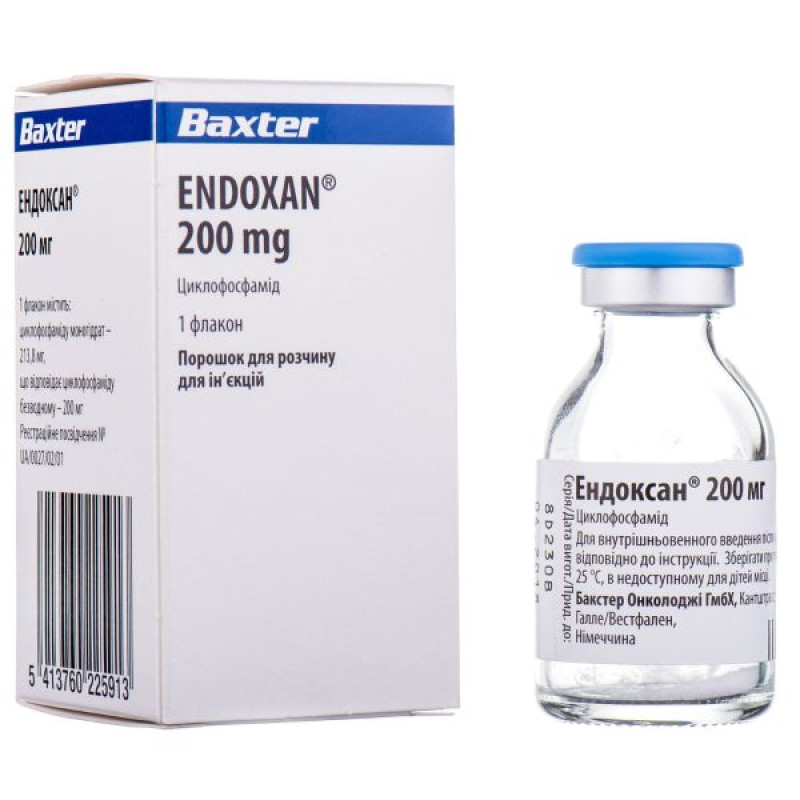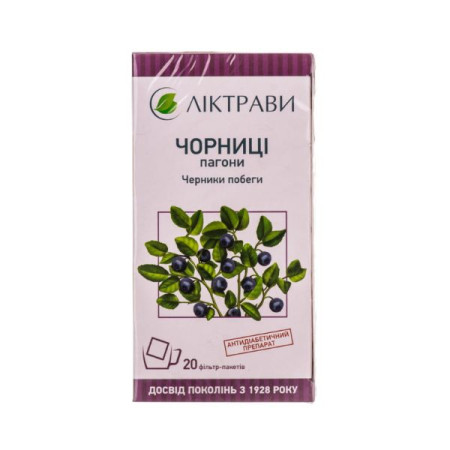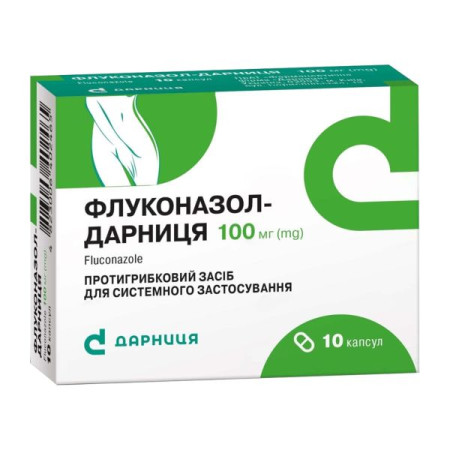Endoxan 200 mg powder for solution for injection 200 mg vial No. 10

Powder for solution for injection "Endoxan ® 200 mg" is intended for use in chemotherapy of the tumors listed below in combination with other antineoplastic agents:
Remission induction and consolidation therapy in acute lymphoblastic leukemia; remission induction in Hodgkin's disease; non-Hodgkin's lymphomas (depending on histological type and stage of the disease also as monotherapy); chronic lymphocytic leukemia (CLL) after failure of standard therapy (chlorambucil/prednisone); remission induction in plasmacytoma (also in combination with prednisone); adjuvant therapy in breast cancer after tumor resection or mastectomy; palliative therapy in advanced breast cancer; advanced ovarian cancer; small cell lung cancer; Ewing's sarcoma; neuroblastoma; rhabdomyosarcoma in children; osteosarcoma.Preparation before allogeneic bone marrow transplantation for:
severe aplastic anemia - as monotherapy or in combination with antiplatelet globulin; acute myeloid and acute lymphoblastic leukemia - in combination with whole body irradiation or busulfan; chronic myeloid leukemia - in combination with whole body irradiation or busulfan.Progressive autoimmune diseases: severe progressive forms of lupus nephritis and Wegener's granulomatosis.
Composition
The active substance is cyclophosphamide (1 vial contains cyclophosphamide monohydrate (213.8 mg), which corresponds to cyclophosphamide anhydrous 200 mg).
Contraindication
The drug is contraindicated in:
Hypersensitivity to cyclophosphamide, its metabolites or other components of the drug; severe bone marrow dysfunction (myelosuppression, especially in patients who have previously been treated with cytotoxic drugs and/or radiotherapy); inflammation of the bladder (cystitis); urinary tract obstruction; active infections; pregnancy or breastfeeding.General contraindications for allogeneic bone marrow transplantation, such as an upper age limit of 50-60 years, contamination of the bone marrow with metastases of malignant (epithelial) tumors, as well as the lack of HLA identity with the planned donor in the case of chronic myeloid leukemia, which must be carefully clarified before starting preparatory therapy with this drug.
Method of application
Dosage should be individualized for each patient. These dosage recommendations apply to both children and adults.
Remission induction and consolidation therapy in acute lymphocytic leukemia
Cyclophosphamide is used in children and adults depending on different risk groups within different polychemotherapy complexes. The typical dosage for the purpose of induction of remission and consolidation therapy in adults is 650 mg/m 2 body surface area (BSA) of cyclophosphamide intravenously, for example in combination with cytarabine and mercaptopurine.
Chronic lymphocytic leukemia
600 mg/m2 PPT cyclophosphamide intravenously on day 6 in combination with vincristine and prednisone or 400 mg/m2 PPT cyclophosphamide intravenously on days 1 and 5, also in combination with vincristine and prednisone, repeat every 3 weeks.
Hodgkin's disease
650 mg/m2 PPT cyclophosphamide intravenously on days 1 and 8 in combination with vincristine, procarbazine, and prednisone (“COPP protocol”).
Non-Hodgkin lymphomas
Cyclophosphamide can be used in non-Hodgkin lymphomas (NHL) depending on the histological type and stage of the disease as monotherapy or in combination with other antineoplastic drugs. The following is the standard therapy for low-grade and intermediate/high-grade non-Hodgkin lymphomas:
Low-grade NHL: 600-900 mg/m2 IV cyclophosphamide on day 1 as monotherapy or in combination with corticosteroids; repeat every 3-4 weeks; intermediate- or high-grade NHL: 750 mg/m2 IV cyclophosphamide on day 1 in combination with doxorubicin, vincristine, and prednisone (CHOP protocol); repeat every 3-4 weeks.Plasmacytoma
1000 mg/m2 PPT cyclophosphamide intravenously on day 1 in combination with prednisone; repeat every 3 weeks.
An example of polychemotherapy, the effectiveness of which has been proven for the treatment of plasmacytoma, is the so-called “VBMCP protocol”, which is given below: 400 mg/m2 PPT cyclophosphamide intravenously on day 1 in combination with melphalan, carmustine, vincristine and prednisone; repeat every 5 weeks.
Breast cancer
Cyclophosphamide should be used for adjuvant and palliative treatment of breast cancer in combination with other cytostatics. The following are two protocols that have been shown to be effective:
"CMF-protocol": 600 mg/m2 PPT cyclophosphamide intravenously on days 1 and 8 in combination with methotrexate and 5-fluorouracil; repeat every 3-4 weeks. "CAF-protocol": 500 mg/m2 PPT cyclophosphamide intravenously on day 1 in combination with doxorubicin and 5-fluorouracil; repeat every 3-4 weeks.Advanced ovarian cancer
750 mg/m2 PPT cyclophosphamide intravenously on day 1 in combination with cisplatin; repeat every 3 weeks.
500-600 mg/m2 PPT cyclophosphamide intravenously on day 1 in combination with carboplatin; repeat every 4 weeks.
Cyclophosphamide should be used in combination with other antineoplastic drugs. As an example of an effective polychemotherapy, the so-called “CAV protocol” is given below: 1000 mg/m2 PPT cyclophosphamide intravenously on day 1 in combination with doxorubicin and vincristine; repeat every 3 weeks.
Ewing's sarcoma
An example of polychemotherapy, the effectiveness of which in Ewing's sarcoma has been proven, is the following "VACA protocol": 500 mg / m 2 PPT cyclophosphamide intravenously 1 time per week in combination with vincristine, doxorubicin and actinomycin D.
Osteosarcoma
Cyclophosphamide should be used as part of a comprehensive polychemotherapy regimen for neoadjuvant (preoperative) and adjuvant (postoperative) therapy. The following is a protocol from the Multi-Institutional Osteosarcoma Study (MIOS) as an example of adjuvant therapy: 600 mg/m2 of cyclophosphamide intravenously daily on day 2 at weeks 2, 13, 26, 39, and 42 of treatment in combination with bleomycin, actinomycin D, doxorubicin, cisplatin, and methotrexate.
Neuroblastoma
Depending on the stage of the disease and the age of the patient, cyclophosphamide should be used in different chemotherapy protocols. An example of a combination therapy for advanced neuroblastoma is the following “OPEC protocol”: 600 mg/m2 PPT cyclophosphamide intravenously on day 1 in combination with vincristine, cisplatin, and teniposide; repeat every 3 weeks.
Rhabdomyosarcoma in children
Cyclophosphamide should be used depending on the stage of the disease and histological type in various protocols of complex polychemotherapy. The typical dosage for patients at stage III (after surgery there is a macroscopic remnant of the tumor) and IV (distant metastases) is 10 mg/kg of body weight of cyclophosphamide intravenously for 3 consecutive days with multiple repetition in combination with vincristine and actinomycin D (the "VAC-Protocol").
Preparation before allogeneic bone marrow transplantation for acute myeloid and acute lymphoblastic leukemia
60 mg/kg body weight of cyclophosphamide intravenously per day for 2 consecutive days in combination with total body irradiation or busulfan.
Note: The appropriate selection of therapy components for combination with cyclophosphamide requires specialized knowledge, as treatment results may vary significantly with different combinations depending on the underlying disease and its stage.
Preparation before allogeneic bone marrow transplantation for chronic myeloid leukemia
60 mg/kg body weight of cyclophosphamide intravenously per day for 2 consecutive days in combination with total body irradiation or busulfan.
Note: in chronic myeloid leukemia, both possible combinations of cyclophosphamide components lead to similar therapeutic results.
Preparation before allogeneic bone marrow transplantation for severe aplastic anemia
The following dosage recommendations apply for preparation without whole-body irradiation, which is usually avoided in severe aplastic anemia: 50 mg/kg of body weight of cyclophosphamide intravenously per day for 4 consecutive days as monotherapy or in combination with antithymocyte globulin.
In the presence of Fanconi anemia, the daily dose should be reduced from 50 to 35 mg/kg of body weight of cyclophosphamide intravenously per day for 4 consecutive days.
Severe progressive forms of lupus nephritis and Wegener's granulomatosis
Initial dose: 500-1000 mg/m2 body surface area intravenously.
Application features
Children
Recommendations for dose selection and use of the drug in children and adolescents are the same as for adult patients.
Drivers
Due to the possible development of side effects such as nausea, vomiting and associated circulatory weakness, the decision as to whether patients treated with the drug can drive or operate complex machinery should be made by the doctor on an individual basis. This is especially true in situations where patients consume alcohol.
Overdose
Serious consequences of overdose include dose-related toxic effects such as myelosuppression, urotoxicity, cardiotoxicity (including heart failure), veno-occlusive liver disease, and stomatitis.
Patients who have received an overdose should be closely monitored for toxic effects, particularly hematotoxicity.
The specific antidote to cyclophosphamide is unknown.
Cyclophosphamide and its metabolites are dialyzed. Therefore, rapid hemodialysis is indicated for the treatment of overdose due to attempted suicide or accidental overdose.
In the event of overdose, the drug should be discontinued and supportive measures should be taken, including appropriate treatment for any concomitant infections, myelosuppression, or other toxic effects.
Side effects
The following adverse reactions have been observed during post-marketing surveillance. The reactions are presented in terms of frequency very common (≥ 1/10).
Blood and lymphatic system disorders: myelosuppression, leukopenia, neutropenia, thrombocytopenia, agranulocytosis, anemia, pancytopenia, decreased hemoglobin level.
On the part of the immune system: immunosuppression.
Skin and subcutaneous tissue disorders: alopecia.
From the kidneys and urinary tract: cystitis, microhematuria.
General disorders and administration site conditions: fever.
Solutions containing benzyl alcohol may reduce the stability of cyclophosphamide.
Storage conditions
Store at a temperature not exceeding 25 °C, out of the reach of children.
During transportation or storage of the drug in the form of a dry substance, temperature fluctuations may cause the cyclophosphamide to melt. It is forbidden to use vials for the preparation of injections with melted contents.
Shelf life in closed bottles is 3 years.
The prepared solution should be used within 24 hours (store at a temperature not exceeding 8 °C).
There are no reviews for this product.
There are no reviews for this product, be the first to leave your review.
No questions about this product, be the first and ask your question.






